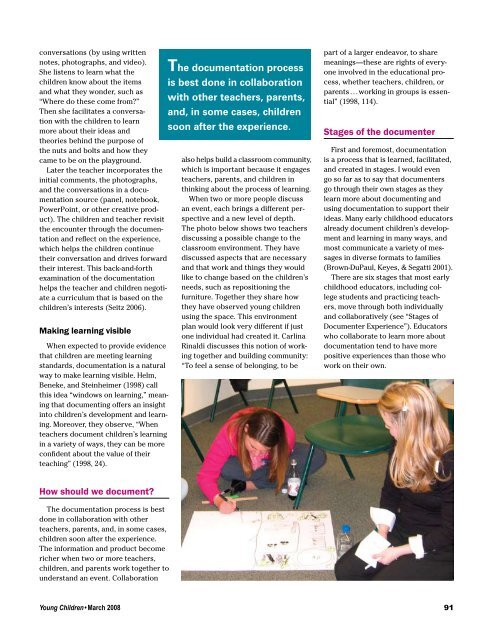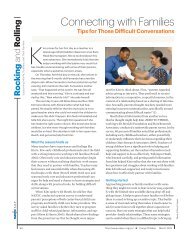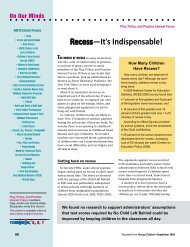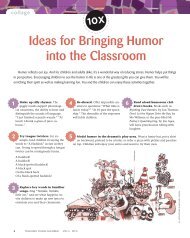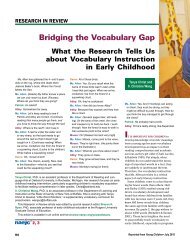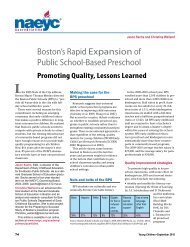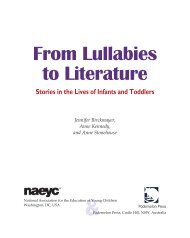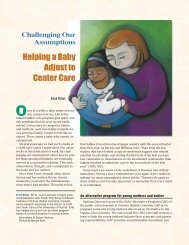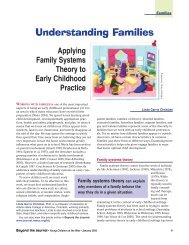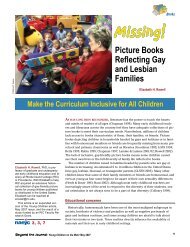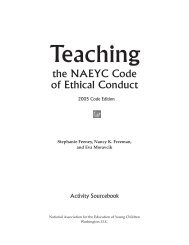The Power of Documentation - National Association for the ...
The Power of Documentation - National Association for the ...
The Power of Documentation - National Association for the ...
Create successful ePaper yourself
Turn your PDF publications into a flip-book with our unique Google optimized e-Paper software.
conversations (by using written<br />
notes, photographs, and video).<br />
She listens to learn what <strong>the</strong><br />
children know about <strong>the</strong> items<br />
and what <strong>the</strong>y wonder, such as<br />
“Where do <strong>the</strong>se come from?”<br />
<strong>The</strong>n she facilitates a conversation<br />
with <strong>the</strong> children to learn<br />
more about <strong>the</strong>ir ideas and<br />
<strong>the</strong>ories behind <strong>the</strong> purpose <strong>of</strong><br />
<strong>the</strong> nuts and bolts and how <strong>the</strong>y<br />
came to be on <strong>the</strong> playground.<br />
Later <strong>the</strong> teacher incorporates <strong>the</strong><br />
initial comments, <strong>the</strong> photographs,<br />
and <strong>the</strong> conversations in a documentation<br />
source (panel, notebook,<br />
<strong>Power</strong>Point, or o<strong>the</strong>r creative product).<br />
<strong>The</strong> children and teacher revisit<br />
<strong>the</strong> encounter through <strong>the</strong> documentation<br />
and reflect on <strong>the</strong> experience,<br />
which helps <strong>the</strong> children continue<br />
<strong>the</strong>ir conversation and drives <strong>for</strong>ward<br />
<strong>the</strong>ir interest. This back-and-<strong>for</strong>th<br />
examination <strong>of</strong> <strong>the</strong> documentation<br />
helps <strong>the</strong> teacher and children negotiate<br />
a curriculum that is based on <strong>the</strong><br />
children’s interests (Seitz 2006).<br />
Making learning visible<br />
When expected to provide evidence<br />
that children are meeting learning<br />
standards, documentation is a natural<br />
way to make learning visible. Helm,<br />
Beneke, and Steinheimer (1998) call<br />
this idea “windows on learning,” meaning<br />
that documenting <strong>of</strong>fers an insight<br />
into children’s development and learning.<br />
Moreover, <strong>the</strong>y observe, “When<br />
teachers document children’s learning<br />
in a variety <strong>of</strong> ways, <strong>the</strong>y can be more<br />
confident about <strong>the</strong> value <strong>of</strong> <strong>the</strong>ir<br />
teaching” (1998, 24).<br />
How should we document?<br />
<strong>The</strong> documentation process is best<br />
done in collaboration with o<strong>the</strong>r<br />
teachers, parents, and, in some cases,<br />
children soon after <strong>the</strong> experience.<br />
<strong>The</strong> in<strong>for</strong>mation and product become<br />
richer when two or more teachers,<br />
children, and parents work toge<strong>the</strong>r to<br />
understand an event. Collaboration<br />
<strong>The</strong> documentation process<br />
is best done in collaboration<br />
with o<strong>the</strong>r teachers, parents,<br />
and, in some cases, children<br />
soon after <strong>the</strong> experience.<br />
also helps build a classroom community,<br />
which is important because it engages<br />
teachers, parents, and children in<br />
thinking about <strong>the</strong> process <strong>of</strong> learning.<br />
When two or more people discuss<br />
an event, each brings a different perspective<br />
and a new level <strong>of</strong> depth.<br />
<strong>The</strong> photo below shows two teachers<br />
discussing a possible change to <strong>the</strong><br />
classroom environment. <strong>The</strong>y have<br />
discussed aspects that are necessary<br />
and that work and things <strong>the</strong>y would<br />
like to change based on <strong>the</strong> children’s<br />
needs, such as repositioning <strong>the</strong><br />
furniture. Toge<strong>the</strong>r <strong>the</strong>y share how<br />
<strong>the</strong>y have observed young children<br />
using <strong>the</strong> space. This environment<br />
plan would look very different if just<br />
one individual had created it. Carlina<br />
Rinaldi discusses this notion <strong>of</strong> working<br />
toge<strong>the</strong>r and building community:<br />
“To feel a sense <strong>of</strong> belonging, to be<br />
part <strong>of</strong> a larger endeavor, to share<br />
meanings—<strong>the</strong>se are rights <strong>of</strong> everyone<br />
involved in <strong>the</strong> educational process,<br />
whe<strong>the</strong>r teachers, children, or<br />
parents . . . working in groups is essential”<br />
(1998, 114).<br />
Stages <strong>of</strong> <strong>the</strong> documenter<br />
First and <strong>for</strong>emost, documentation<br />
is a process that is learned, facilitated,<br />
and created in stages. I would even<br />
go so far as to say that documenters<br />
go through <strong>the</strong>ir own stages as <strong>the</strong>y<br />
learn more about documenting and<br />
using documentation to support <strong>the</strong>ir<br />
ideas. Many early childhood educators<br />
already document children’s development<br />
and learning in many ways, and<br />
most communicate a variety <strong>of</strong> messages<br />
in diverse <strong>for</strong>mats to families<br />
(Brown-DuPaul, Keyes, & Segatti 2001).<br />
<strong>The</strong>re are six stages that most early<br />
childhood educators, including college<br />
students and practicing teachers,<br />
move through both individually<br />
and collaboratively (see “Stages <strong>of</strong><br />
Documenter Experience”). Educators<br />
who collaborate to learn more about<br />
documentation tend to have more<br />
positive experiences than those who<br />
work on <strong>the</strong>ir own.<br />
Young Children • March 2008 91


